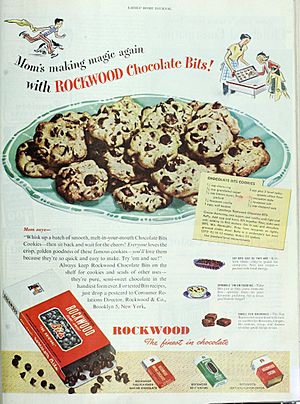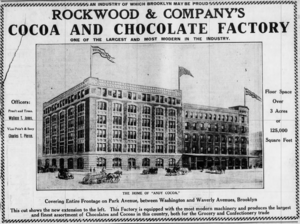- This page was last modified on 11 July 2024, at 13:05. Suggest an edit.
Rockwood & Company facts for kids

1948 advertisement in Ladies' Home Journal for Rockwood Chocolate Bits.
Rockwood & Company was a New York City-based chocolatier which operated from 1886 until 1957. It coordinated the industry's first resale price contracts, operated the largest chocolate factory in New York, and was the second largest producer of chocolate in the United States, after the Hershey Company. Founded in the borough of Manhattan, it moved to the Brooklyn neighborhood of Wallabout, gradually expanding its footprint to occupy most of a city block. In 1919, a fire led to a flood of chocolate in the street, attracting a crowd of children. Rockwood & Company sold the factory to the Sweets Company of America in 1957, who used it to produce Tootsie Rolls until it closed in 1967. The Rockwood & Company factory complex was listed on the National Register of Historic Places in 1983, which was later merged into the Wallabout Industrial Historic District. It was converted to luxury apartments in 1996.
Business
Wallace T. Jones and W. E. Rockwood founded Rockwood & Company in 1886 and originally operated a chocolate factory on Cherry Street in Manhattan until 1904, when it moved to Brooklyn. At the time, it was the second largest producer of chocolate in the country, next to Hershey's. It processed raw cocoa into chocolate and made coatings, bars, cocoa, baking chocolate, and other confections. Rockwood may have been the first to introduce chocolate sprinkles (marketed as "Decorettes") to the United States circa 1915, and in later years its bestselling product was chocolate chips (marketed as "Chocolate Bits").
The company's treasurer, William M. Evans, was elected president in 1923 and moved to the role of Chairman of the Board in 1933 until his death in 1944. Jones' son, Wallace Thaxter Jones, became president in 1933. The factory's 1,000 workers went on strike for eleven days in August 1937, after a Pennsylvania chocolate workers' strike earlier that year. A few months later, Rockwood was part of the industry's first resale price contracts when it ensured its product, Pecan Feast, would be sold for a minimum of 5 cents. Rockwood was one of the suppliers of military chocolate during World War II, though Hershey's played a larger role.
When the younger Jones died in 1946, H. Russell Burbank was promoted from executive vice president to president or Rockwood & Co. Among its marketing activities Rockwood awarded $1,000 scholarships to winners of the Pillsbury bake-off if they used Rockwood products. This tactic bore fruit when an entry for "Starlight Mint Surprise Cookies" won the $10,000 second prize at the 1949 contest, and the recipe was included in packages of both Pillsbury and Rockwood products. The New York Times reported on a string of cocoa bean thefts at the factory in 1954, and how the police followed a truck driver who was selling part of his cargo. Two hundred thousand dollars of cocoa beans were estimated to have been stolen, at the then-price of 54¢ a pound, dropped off at a Gowanus Canal warehouse while being transported to the Erie Basin.
The company was affected by a global shortage and rise in the price of cocoa beans that year to more than 60¢ a pound. Spending more on beans, but unable to change the retail price, the company started losing money. As they looked to sell the company, Jay Pritzker purchased a controlling interest of Rockwood stock, stopping the production of cocoa butter in order to sell cocoa beans themselves through a loophole which would avoid paying tax on the sale. He traded the beans to shareholders for more of the company's stock. His pricing ensured shareholders would want to sell, and presented an opportunity for arbitrage that Graham-Newman took advantage of, buying shares and immediately trading them to Pritzker for more valuable beans. A young Warren Buffett, who worked at Graham-Newman, bought shares but did not participate in arbitrage, understanding from Pritzker's point of view that, in the end, the more profitable company would be worth more. The stock price more than quintupled in the end.
There was another strike in 1957, when the workers, who were members of the Bakery and Confectionary Workers International Union, stopped work amid concerns over severance payments in case the company went out of business. The following month, April 1957, the Rockwood Chocolate division was sold to the Sweets Company of America (now Tootsie Roll Industries). As part of the deal, the union sacrificed half of their vacation pay.
Brooklyn factory complex
The original Brooklyn building is on the corner of Park Avenue and Washington Street, in the Wallabout neighborhood, which was a major industrial center at the time. It was initially constructed in 1890 for the Van Glahn Brothers grocer. Their success drove them to expand north towards Flushing Avenue and then west towards Waverly Ave, acquiring the rest of the Van Glahn Brothers properties and erecting new buildings. Among the new construction was a new factory on the northwest part of the block, on the corner of Waverly and Park. Parfitt Brothers designed it, with a showroom on the first floor designed by Ernest Flagg. According to the Brooklyn Daily Eagle in 1910, it was the largest chocolate factory in the state and one of the largest in the country. It increased the total factory floor space to more than 125,000 square feet.
In May 1919, a fire broke out in the shipping department, where large quantities of chocolate was stored in burlap bags. The fire began in the early morning, so it burned for longer than it would have later in the day, though was confined to the one building. Over the course of the three hours firefighters tried to put out the fire, the water they would fire into the building ran back out, mixed with melted chocolate. The sugar and butter solidified and blocked the sewers on the street. The Eagle report about the fire focused on the "thousand and one urchins hurried to the fire ... for word had passed along the river front that an ocean of fudge was flooding the street ... accessible to all who ventured near". Eventually, someone called the truant department, leading to "chocolate-gorged truants, some with far-away looks in their eyes [hauled] off to school".
In 1938, another fire spread from neighboring Screen-Droge Paper Company, causing more than $100,000 in damage. It was caused by an employee at the paper company, who dropped a cigarette. According to the New York Times, the smoke was heavy, making it difficult for firefighters, ten of whom were overcome by smoke.
After the factory was sold to Sweets Company of America in 1957, it produced Tootsie Rolls and operated for ten more years, before closing in 1967.
In 1983, it was listed on the National Register of Historic Places as the Rockwood Chocolate Factory Historic District, but remained vacant until 1996, when a developer purchased it and converted it into luxury apartments. The factory complex, and the rest of the historic district, was incorporated into the larger Wallabout Industrial Historic District in 2012.

